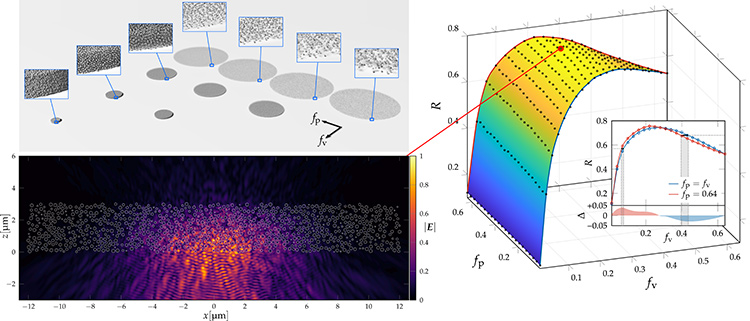 Top left: Subset of fixed-thickness configurations investigated, comprising 8×104 TiO2 nanospheres with a diameter of 200 nm embedded in a polymer matrix. Volume density (fv) and degree of packing correlations (fp) are varied independently. Right: Total reflectance obtained for each configuration, exhibiting an absolute maximum (red marker) at a filling fraction of 25 percent and a packing fraction of 49 percent. Bottom left: Corresponding absolute value of the total electric field, plotted for a cross-cut plane. [Enlarge figure]
Top left: Subset of fixed-thickness configurations investigated, comprising 8×104 TiO2 nanospheres with a diameter of 200 nm embedded in a polymer matrix. Volume density (fv) and degree of packing correlations (fp) are varied independently. Right: Total reflectance obtained for each configuration, exhibiting an absolute maximum (red marker) at a filling fraction of 25 percent and a packing fraction of 49 percent. Bottom left: Corresponding absolute value of the total electric field, plotted for a cross-cut plane. [Enlarge figure]
Highly opaque, multiple scattering systems serve many technological purposes, from basic paint and coatings for diffuse reflection, to more advanced applications in the fields of light harvesting, radiative cooling or cryptography.1 Despite its long-standing relevance, however, the rich light-transport physics in disordered media still has several fundamental aspects under active research.2,3
Even basic questions such as what particle density or spatial correlations provide maximum scattering efficiency remain open. On the one hand, poor reproducibility of fabrication and measurement conditions hinder the comparison between different experiments. On the other, rigorous numerical approaches are notoriously impractical for large 3-D disordered structures.
To address these issues, we adopted a rigorous model to solve Maxwell’s equations in large aggregates of scattering nanoparticles—something now made possible by the massively parallel computing capabilities of modern graphics processing units. In recent publications, we developed a software implementation of the multi-particle T-matrix method4 and used it to perform a comprehensive numerical survey encompassing the full range of particle densities and spatial correlations that can be accessed for different packings of hard spheres.5
By varying the structural parameters independently, we revealed that two distinct “phases” can be defined in which spatial correlations play opposite roles in terms of scattering efficiency, an effect arising when near-field coupling is decreased at the expense of an increased medium homogeneity. Applying our results to the exemplary case of white paint, we determined the structural parameters corresponding to the highest scattering efficiency and provided a lower bound for the scattering strength in such discrete random media.
This has implications not just for fundamental physics but also for industry applications and environmental protection, since we show how tuning correlations can lead to enhanced turbidity with reduced nanoparticle density. Our results pave the way to further full-wave investigations of large 3-D aperiodic structures, the study of which has so far been substantially limited to approximate or effective models.
Researchers
Lorenzo Pattelli, Università di Firenze, Sesto Fiorentino, Italy
Amos Egel and Uli Lemmer, Karlsruhe Institute of Technology, Karlsruhe, Germany
Diederik S. Wiersma, Università di Firenze and Istituto Nazionale di Ricerca Metrologica, Turin, Italy
References
1. D.S. Wiersma. Nat. Photon. 7, 3 (2013).
2. T. Sperling et al. New J. Phys. 18, 013039 (2016).
3. S. Rotter and S. Gigan. Rev. Mod. Phys. 89, 015005 (2017).
4. A. Egel et al. J. Quant. Spectrosc. Radiat. Transfer 199, 103 (2017).
5. L. Pattelli et al. Optica 5, 9 (2018).
